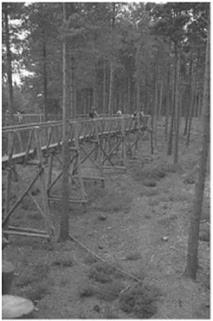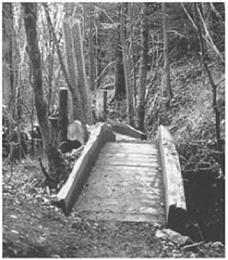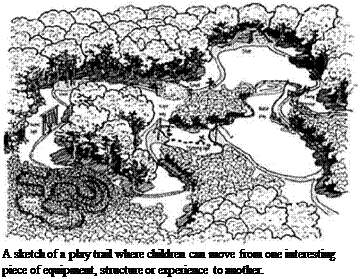 |
Apart from the naturally occurring materials or earthworks, any structures constructed in the play area should be robust, free from safety hazards, and as far as possible should possess sustainable origins. Timber is likely to be a common material, and is best used in large dimensions because of the larger scale of the outdoors and to distinguish it from urban play areas. Other appropriate materials are sisal and polypropylene rope, galvanized chain and bolts. All of these are durable, require little maintenance, and can be constructed to meet the various safety and construction standards required by different countries or states. The following are some hints on construction and safety.
|
Children can use their own imagination and materials found in the landscape. Here a primitive hut has been made from branches. Dalby Woods, Sweden. |
– Posts should be set well into the ground, and should normally be concreted in. Take care that the top of the concrete does not protrude above ground level. Even if it is set down low at construction, erosion during use might expose it.
– Ensure that bolts are countersunk, and that protruding ends are cut off cleanly and as flush with the nut as possible.
– Chains should have links that cannot trap small fingers.
– Timber should be peeled and rounded before use. Edges should be sanded and chamfered to reduce the risk of splinters.
Other materials that may be used are:
– old car tyres, which can be recycled as swing seats or shock absorbers on moving parts such as aerial ropeways;
– fibreglass for tubes or special constructions;
– stainless steel for contour slides;
– galvanized steel tube for ladder rungs, strengthening of structures and for firemen’s poles.
Not all of these are sustainable: wood laminate may substitute
for fibreglass and stainless steel under some circumstances.
|
|
This exciting trail high up in the tree-tops offers a new perspective on the world. Ringwood Forest, Hampshire, England.
|
|
This interesting bridge has a drawbridge section on it. Walk on to it and it descends,
allowing a person to cross. Haldon Forest,
Devon, England.
Materials to be avoided are:
– non-galvanized or non-stainless steel, as this has to be painted, and rusts too easily;
– concrete, as this is too hard, urban, unforgiving and dangerous for children.
Surfacing beneath structures, particularly tall ones, should be soft and resilient so as to prevent injury if children fall. The following materials are well proven and sustainable:
–
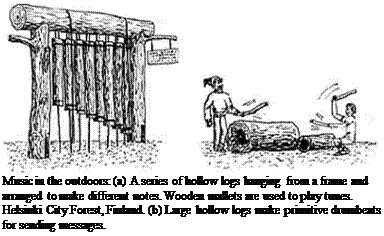 |
 |
Wood chips. These work well in a forest or countryside setting. They absorb impacts well, are relatively hard – wearing and cheap. Once used or contaminated they can be removed and recycled as mulch.
 |
– Bark. Pine bark has similar properties to wood chips. It is soft, has a pleasant ‘forest’ smell and an earthy colour that blends with the outdoors, and is cheap.
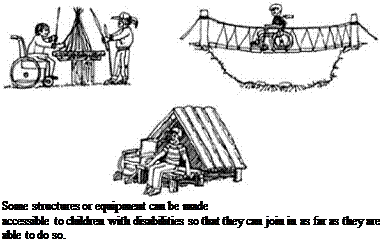 |
Both these materials need periodic cleaning to remove litter, and must be laid on well-drained sub-bases, as they tend to soak up moisture. This can cause them to freeze in the winter, or ferment and release tannins from the material, which creates a strong-smelling effluent.
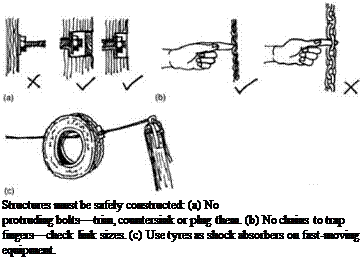 |
– Sand. This is better in seaside areas, deserts, heathy places or other sites where bark or wood chips
would not fit in or are not available. It is quite soft to land on if it is dry, but it tends to adhere to clothing, get inside shoes and blow into eyes. The abrasive quality of sand can increase wear and tear on moving parts.
Safety surfaces should be retained within log kerbs, which should follow the outline of the safety zones, thus helping to demarcate them. It is essential that they are kept loose and clean. Pets must be kept clear of the area, and all glass objects should be banned. Surfaces to avoid are anything hard such as tarmac, and grass, which also wears too easily, especially under moving equipment.



